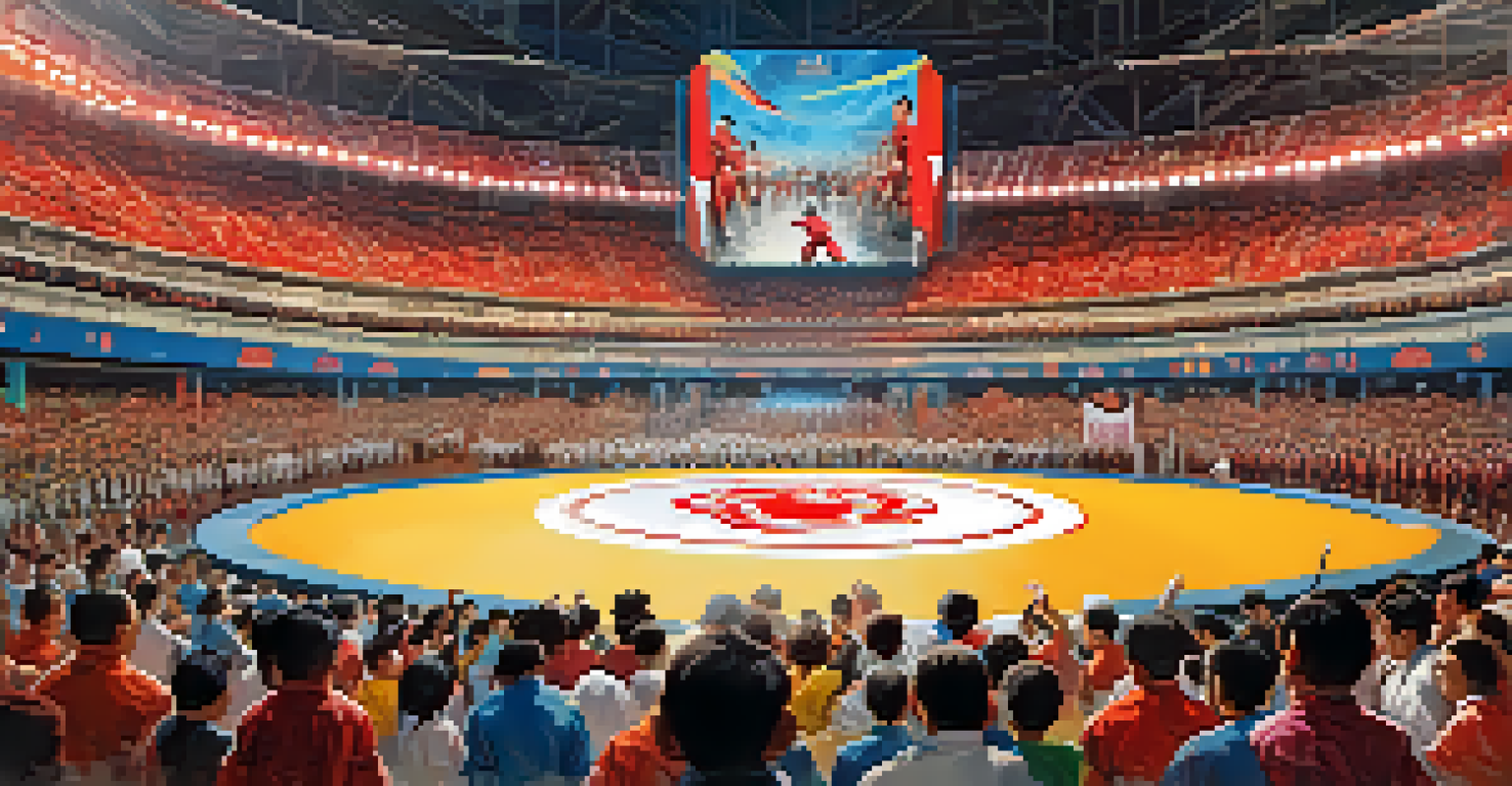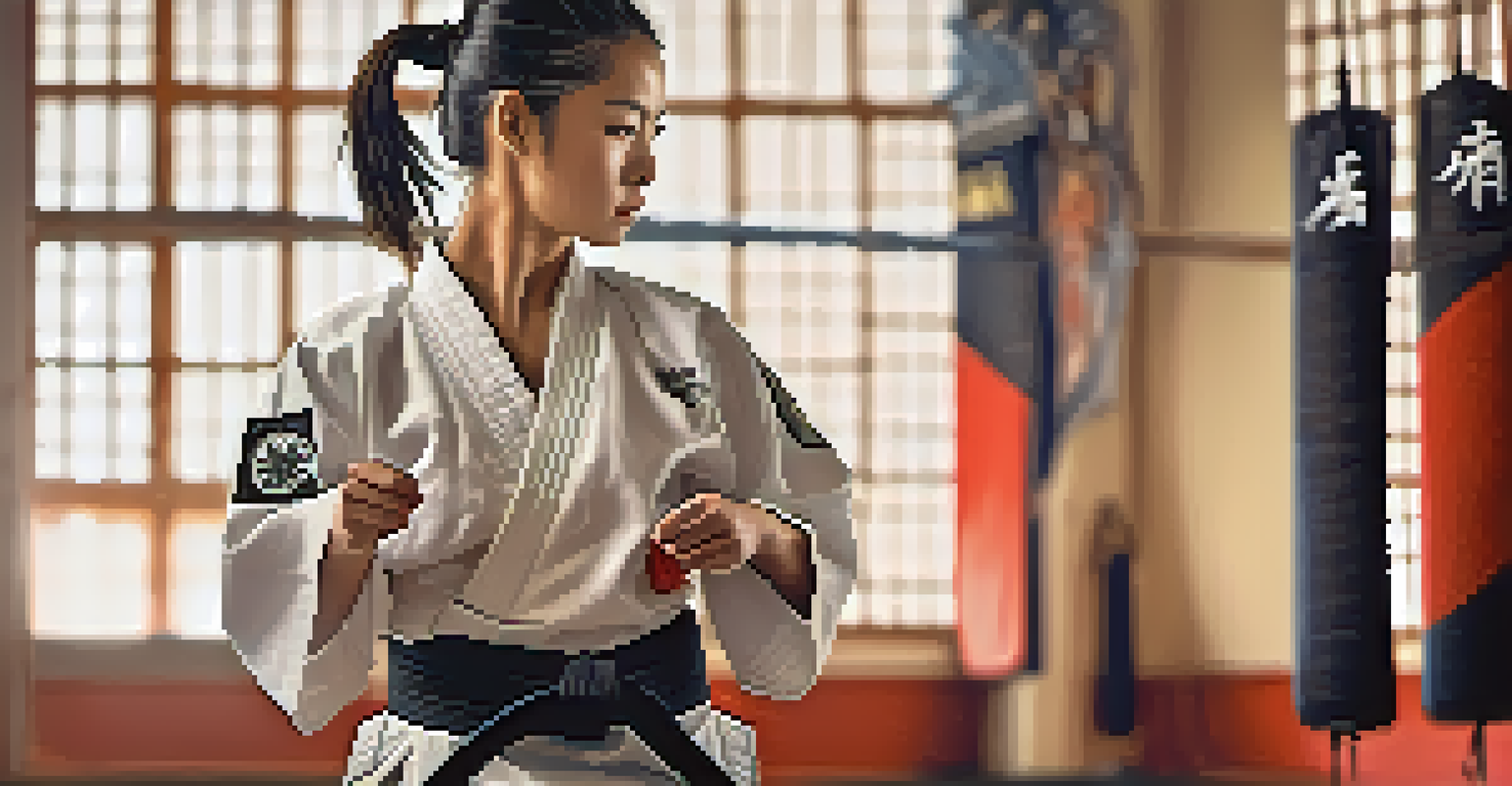The Evolution of Martial Arts in Global Competitions Today

Historical Roots of Martial Arts and Their Global Spread
Martial arts have a rich history that dates back thousands of years, with origins in various cultures. From the ancient Chinese martial arts to the Japanese samurai disciplines, each form was developed for combat, self-discipline, and spiritual growth. As these practices evolved, they spread across continents through trade, migration, and cultural exchange, influencing one another.
Martial arts is not about fighting; it's about finding peace within oneself.
The globalization of martial arts can be seen through the lens of colonization and the sharing of knowledge. For instance, the introduction of Judo and Karate to the West in the early 20th century sparked interest and led to the establishment of schools. This cross-cultural movement created a melting pot of styles and techniques, allowing practitioners to learn from one another.
Today, martial arts are celebrated globally, not just as a means of self-defense but as a sport and art form. The rich tapestry of styles, including Brazilian Jiu-Jitsu, Taekwondo, and Muay Thai, showcases how these disciplines have adapted and merged, paving the way for their presence in international competitions.
The Role of Global Competitions in Martial Arts Evolution
Global competitions have played a pivotal role in the evolution of martial arts, acting as a platform for practitioners to showcase their skills. Events like the Olympics and World Championships have brought martial arts into the spotlight, attracting athletes from diverse backgrounds. These competitions not only elevate the sport but also foster a sense of community among martial artists worldwide.

With the rise of mixed martial arts (MMA), we’ve seen an intriguing blend of techniques from various disciplines. Fighters must adapt and evolve their styles to succeed in this dynamic environment, leading to innovative training methods and strategies. This evolution has pushed traditional martial arts to evolve, incorporating new techniques while preserving their core principles.
Martial Arts' Cultural Journey
Martial arts reflect the rich cultural values and histories of their regions, showcasing diverse practices like Kendo and Capoeira.
Additionally, the visibility of martial arts competitions has spurred interest among the younger generation. Kids are now joining dojos and training centers at an early age, inspired by athletes they see on television. This engagement ensures that martial arts continue to thrive and evolve, as new talent emerges to carry on the legacy.
Impact of Technology on Martial Arts Training and Competitions
In today's digital age, technology has significantly impacted how martial arts are practiced and taught. Online tutorials, virtual classes, and training apps provide access to expert instruction from anywhere in the world. This democratization of knowledge allows aspiring martial artists to learn at their own pace, regardless of their geographical location.
The ultimate aim of martial arts is not having to use them.
Moreover, technology plays a crucial role in enhancing competition experience. Live streaming events and social media have transformed how competitions are viewed, allowing fans to engage in real-time. Athletes can now share their training journeys, inspiring others and building a global community around their sport.
However, technology's influence isn't limited to training and viewing; it's also changing how competitions are judged. Advanced scoring systems and video replays are being introduced to ensure fairness and accuracy. This shift toward a tech-driven approach is setting new standards for accountability in martial arts competitions.
Cultural Significance of Martial Arts in Various Countries
Martial arts often reflect the cultural values and history of the regions they originate from. For instance, in Japan, the practice of Kendo is not just about combat; it embodies principles of respect, discipline, and honor. This cultural significance adds depth to the practice, making it more than just a physical activity.
In countries like Brazil, Capoeira combines martial arts with music and dance, showcasing the rich African heritage and the spirit of resistance. This blend of culture and combat creates a unique experience for practitioners, emphasizing the importance of community and expression beyond mere fighting techniques.
Women in Martial Arts Rise
The increasing participation of women in martial arts competitions is transforming the sport and inspiring future generations.
Understanding the cultural significance of martial arts enhances the appreciation for these disciplines. As athletes compete on global stages, they carry with them the essence of their cultures, promoting a greater understanding and respect among nations.
The Rise of Women's Participation in Martial Arts Competitions
Over the past few decades, there has been a remarkable increase in women's participation in martial arts, both in training and competitions. This shift has been pivotal in transforming the perception of martial arts as a male-dominated arena. Women from various backgrounds are stepping into the ring, showcasing their skills and determination.
Organizations and events dedicated to promoting women's martial arts have emerged, providing platforms for female athletes to shine. Competitions like the Women's MMA Championship highlight the extraordinary talent and dedication of female fighters, inspiring a new generation of women to take up martial arts. These events also foster a sense of empowerment and community among female practitioners.
This rise in participation is not just about inclusion; it also elevates the overall quality of competitions. Diverse perspectives and techniques enrich the martial arts landscape, pushing all athletes to improve and innovate. As more women enter the scene, the spirit of competition becomes even more vibrant and inspiring.
The Future of Martial Arts in Global Competitions
Looking ahead, the future of martial arts in global competitions is promising, with evolving styles and formats. The popularity of MMA has paved the way for the integration of different techniques, leading to the emergence of hybrid martial arts. This evolution keeps the sport fresh and exciting, appealing to new audiences.
Furthermore, as more countries embrace martial arts, we can expect to see regional styles gaining recognition on the global stage. This diversification could lead to unique competitions that celebrate the richness of martial arts from around the world, fostering greater unity among practitioners.
Tech's Impact on Martial Arts
Technology is revolutionizing martial arts training and competitions, enhancing accessibility and fairness in the sport.
The ongoing influence of technology will likely shape how martial arts evolve as well. Virtual reality training, advanced analytics, and global streaming of competitions will enhance the training experience and broaden the reach of martial arts. As we embrace these changes, the future of martial arts looks bright and full of potential.
Conclusion: Celebrating the Journey of Martial Arts
The journey of martial arts from their historical roots to their current global presence is a testament to their enduring appeal. As they continue to evolve, martial arts remain a powerful means of self-expression, discipline, and community. The fusion of tradition and modernity creates a dynamic landscape that appeals to practitioners of all ages and backgrounds.
In celebrating the evolution of martial arts, we honor the countless individuals who have dedicated their lives to these disciplines. Their passion, resilience, and commitment have paved the way for future generations, ensuring that martial arts will thrive for years to come.

As we look to the future, it's essential to appreciate the rich history and diverse cultures that contribute to the martial arts world. By fostering inclusivity, embracing change, and celebrating the spirit of competition, we can ensure that martial arts remain a vibrant and inspiring part of global culture.